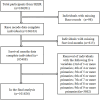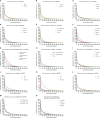Prognostic analysis of lung squamous cell carcinoma patients with second primary malignancies: a SEER database study
- PMID: 38444672
- PMCID: PMC10912175
- DOI: 10.3389/fonc.2024.1294383
Prognostic analysis of lung squamous cell carcinoma patients with second primary malignancies: a SEER database study
Abstract
Background: As lung squamous cell carcinoma (LUSC) patients are at increased risk of developing a second primary cancer, this complicates the patient's condition and thus makes prognostic assessment more difficult, posing a significant prognostic challenge for clinicians. Our goal was to assess the prognosis of LUSC patients with a second primary tumor, and provide insights into appropriate therapy and monitoring strategies.
Methods: Data was obtained for LUSC patients from the Surveillance, Epidemiology, and End Results (SEER) database. The LUSC patients were divided into three groups (LS-SPM, OT-LUSC and LUSC-only). Univariate and stratified analyses were performed for the baseline and clinical characteristics of the participants. Multiple regression and Kaplan-Meier survival analyses were also performed, followed by a final life table analysis.
Results: In our sample of 101,626 patients, the HR for OS in the LS-SPM group was 0.40 in univariate analysis. Kaplan-Meier survival curves showed that LS-SPM patients had considerably longer lifespans compared to the other groups. The LS-SPM patients had median and mean survival times of 64 months and 89.11 months. Unadjusted and adjusted multiple regression analyses showed that LS-SPM patients had a superior survival compared to LUSC-only and OT-LUSC groups.
Conclusion: LS-SPM patients have a good prognosis with aggressive therapy and immune monitoring. The present study offers novel insights into the pathophysiological causes and treatments for LS-SPM.
Keywords: NSCLC; SEER; lung squamous cell carcinoma; second primary malignancy; survival time.
Copyright © 2024 Han, Wang, Su, Xu and Wei.
Conflict of interest statement
The authors declare that the research was conducted in the absence of any commercial or financial relationships that could be construed as a potential conflict of interest.
Figures



Similar articles
-
Better survival and prognosis in SCLC survivors after combined second primary malignancies: A SEER database-based study.Medicine (Baltimore). 2023 Feb 10;102(6):e32772. doi: 10.1097/MD.0000000000032772. Medicine (Baltimore). 2023. PMID: 36820587 Free PMC article.
-
Better Prognosis and Survival in Esophageal Cancer Survivors After Comorbid Second Primary Malignancies: A SEER Database-Based Study.Front Surg. 2022 May 6;9:893429. doi: 10.3389/fsurg.2022.893429. eCollection 2022. Front Surg. 2022. PMID: 35769151 Free PMC article.
-
LINC00628 is differentially expressed between lung adenocarcinoma and squamous cell carcinoma and is associated with the prognosis of NSCLC.Oncol Lett. 2022 Feb;23(2):55. doi: 10.3892/ol.2021.13173. Epub 2021 Dec 21. Oncol Lett. 2022. PMID: 34992687 Free PMC article.
-
Systematic analysis of apoptosis-related genes in the prognosis of lung squamous cell carcinoma: a combined single-cell RNA sequencing study.J Thorac Dis. 2023 Dec 30;15(12):6946-6966. doi: 10.21037/jtd-23-1712. Epub 2023 Dec 26. J Thorac Dis. 2023. PMID: 38249925 Free PMC article.
-
Based on the Development and Verification of a Risk Stratification Nomogram: Predicting the Risk of Lung Cancer-Specific Mortality in Stage IIIA-N2 Unresectable Large Cell Lung Neuroendocrine Cancer Compared With Lung Squamous Cell Cancer and Lung Adenocarcinoma.Front Oncol. 2022 Jun 30;12:825598. doi: 10.3389/fonc.2022.825598. eCollection 2022. Front Oncol. 2022. PMID: 35847910 Free PMC article. Review.
Cited by
-
Impact of radiotherapy on second primary lung cancer incidence and survival in esophageal cancer survivors.Sci Rep. 2024 Jul 31;14(1):17720. doi: 10.1038/s41598-024-67753-9. Sci Rep. 2024. PMID: 39085347 Free PMC article.
References
LinkOut - more resources
Full Text Sources
Research Materials

